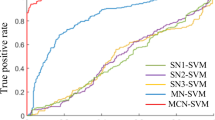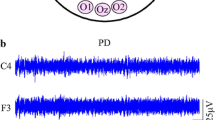Abstract
To explore the abnormal brain activity of early Parkinson’s disease with mild cognitive impairment (ePD-MCI) patients, the study analyzed the dynamic fluctuation of electroencephalogram (EEG) signals and the dynamic change of information communication between EEG signals of ePD-MCI patients. In this study, we recorded resting-state EEG signals of 30 ePD-MCI patients and 37 early Parkinson’s disease without mild cognitive impairment (ePD-nMCI) patients. First, we analyzed the difference of the complexity of EEG signals between the two groups. And we found that the complexity in the ePD-MCI group was significantly higher than that in the ePD-nMCI group. Then, by analyzing the dynamic functional network (DFN) topology based on the optimal sliding-window, we found that the temporal correlation coefficients of ePD-MCI patients were lower in the delta and theta bands than those in the ePD-nMCI patients. The temporal characteristic path length of ePD-MCI patients in the alpha band was higher than that of ePD-nMCI patients. In the theta and alpha bands, the temporal small world degrees of ePD-MCI patients were lower than that of patients with ePD-nMCI. In addition, the functional connectivity strength of ePD-MCI patients affected by cognitive impairment was weaker than that of ePD-nMCI patients, and the stability of dynamic functional connectivity network was decreased. This finding may serve as a biomarker to identify ePD-MCI and contribute to the early intervention treatment of ePD-MCI.











Similar content being viewed by others
References
Aarsland D, Creese B, Politis M (2017) Cognitive decline in Parkinson disease. Nat Rev Neurol 13(4):217–231
Abásolo D, Hornero R, Espino P (2013) Approximate entropy of EEG background activity in Alzheimer’s disease patients. Intell Automa Soft Comput 12:591–603
Allen EA, Damaraju E, Plis SM (2014) Tracking Whole-Brain connectivity dynamics in the resting state. Cereb Cortex 24(3):663–676
Bai F, Watson DR, Yu H (2009) Abnormal resting-state functional connectivity of posterior cingulate cortex in amnestic type mild cognitive impairment. Brain Res 1302(20):167–174
Becker JT, Mintun MA, Aleva K, Wiseman MB (1996) Compensatory reallocation of brain resources supporting verbal episodic memory in Alzheimer’s disease. Neurology 46(3):692–700
Bellomo G, Paoletti FP, Chipi E (2020) A/T/(N) profile in cerebrospinal fluid of Parkinson’s disease with/without cognitive impairment and dementia with Lewy bodies. Diagnostics 10(12):1015
Bertrand JA, Mcintosh R, Postuma RB (2015) Brain connectivity alterations are associated with dementia in Parkinson’s disease. Brain Connect 6(3):216–224
Cai S, Hong L, Fu Z (2011) Regression analysis of EEG signals based on complex network. J Univ Sci Technol China 41(4):330–333
Cao Y, Cai L, Wang J, Wang R, Yu H, Cao Y, Liu J (2015) Characterization of complexity in the electroencephalograph activity of Alzheimer’s disease based on fuzzy entropy. Chaos 25(8)
Carmona J, Tobon CA, Suarez-Revelo JX (2019) Resting functional connectivity and mild cognitive impairment in Parkinson’s disease. An electroencephalogram study. Future Neurol 14(2)
Chang C, Glover GH (2010) Time-frequency dynamics of resting-state brain connectivity measured with fMRI. Neuroimage 50(1):81–98
Chen W, Wang Z, Xie H (2007) Characterization of surface EMG signal based on fuzzy entropy. IEEE Trans Neural Syst Rehabil Eng 15(2):266–272
Chen W, Xu ZM, Wang G (2012) Non-motor symptoms of Parkinson’s disease in China: a review of the literature. Parkinsonism Relat Disord 18(5):446–452
Chen S, Chan P, Sun S (2016) The recommendations of Chinese Parkinson’s disease and movement disorder society consensus on therapeutic management of Parkinson’s disease. Transl Neurodegener 5(1):1–12
Cordes D, Zhuang X, Kaleem M (2018) Advances in functional magnetic resonance imaging data analysis methods using Empirical Mode Decomposition to investigate temporal changes in early Parkinson’s disease. Alzheimer’s Dementia Transl Res Clin Interv 4:372–386
Damaraju E, Allen EA, Belger A (2014) Dynamic functional connectivity analysis reveals transient states of dysconnectivity in schizophrenia. NeuroImage Clin 5:298–308
Díez-Cirarda M et al (2018) Dynamic functional connectivity in Parkinson’s disease patients with mild cognitive impairment and normal cognition. NeuroImage Clin 17:847–855
Duan F, Huang Z, Sun Z (2020) Topological network analysis of early Alzheimer’s disease based on resting-state EEG. IEEE Trans Neural Syst Rehabil Eng 28(10):2164–2172
Fernndez A, Hornero R, Gomez C (2010) Complexity analysis of spontaneous brain activity in Alzheimer disease and mild cognitive impairment a MEG study. Alzhmer Dis Assoc Disord 24(2):182–189
Fox MD, Snyder AZ, Vincent JL, Corbetta M, Van Essen DC, Raichle ME (2005) The human brain is intrinsically organized into dynamic, anticorrelated functional networks. Proc Natl Acad Sci USA 102(27):9673–9678
Gill DJ, Freshman A, Blender JA (2008) The Montreal cognitive assessment as a screening tool for cognitive impairment in Parkinson’s disease. Mov Disord 23(7):1043–1046
Goetz CG, Poewe W, Rascol O (2004) Movement disorder society task force report on the Hoehn and Yahr staging scale: status and recommendations the movement disorder society task force on rating scales for Parkinson’s disease. Mov Disord 19(9):1020–1028
Gomez C, Poza J, Gomez-Pilar J (2016) Analysis of spontaneous EEG activity in Alzheimer’s disease using cross-sample entropy and graph theory. In: International conference of the ieee engineering in medicine & biology society
Greicius MD, Srivastava G, Reiss AL (2004) Default-mode network activity distinguishes Alzheimer’s disease from healthy aging: evidence from functional MRI. Proc Natl Acad Sci USA 101(13):4637–4642
Hassan M, Chaton L, Benquet P, Delval A (2017) Functional connectivity disruptions correlate with cognitive phenotypes in Parkinson’s disease. NeuroImage Clin 14:591–601
Holtzheimer PE, Mayberg HS (2011) Stuck in a rut: rethinking depression and its treatment. Trends Neurosci 34(1):1–9
Jones DT, Vemuri P, Murphy MC, Gunter JL, Senjem ML, Machulda MM, Przybelski SA, Gregg BE, Kantarci K, Knopman DS, Boeve BF, Petersen RC, Jack CR Jr (2012) Non-Stationarity in the Resting Brain’s Modular Architecture. PLoS ONE 7(6):e39731
Kalia LV, Lang AE (2015) Parkinson’s disease. The Lancet 386(9996):896–912
Kugiumtzis D (2002) Surrogate data test on time series. Model Forecast Financial Data 2:267–282
Litvan I, Aarsland D, Adler CH (2011) MDS task force on mild cognitive impairment in Parkinson’s disease: critical review of PD-MCI. Mov Disord 26(10):1814–1824
Liu X, Duyn JH (2013) Time-varying functional network information extracted from brief instances of spontaneous brain activity. Proc Natl Acad Sci 110(11):4392–4397
Lopes R, Delmaire C, De Febvre L (2017) Cognitive phenotypes in Parkinson’s disease differ in terms of brain-network organization and connectivity. Hum Brain Mapp 38:1604–1621
Ma CL, Su L, Xie JJ (2014) The prevalence and incidence of Parkinson’s disease in China: a systematic review and meta-analysis. J Neural Transm (Vienna) 121(2):123–134
Majeed W, Magnuson M, Hasenkamp W (2011) Spatiotemporal dynamics of low frequency BOLD fluctuations in rats and humans. Neuroimage 54(2):1140–1150
Maturana-Candelas A, Gómez C, Poza J (2019) EEG characterization of the Alzheimer’s disease continuum by means of multiscale entropies. Entropy 21(6)
Mehraram R, Kaiser M, Cromarty R, Graziadio S (2020) Weighted network measures reveal differences between dementia types: an EEG study. Hum Brain Mapp 41(6):1573–1590
Mioshi E, Dawson K, Mitchell J, Arnold R, Hodges JR (2006) The Addenbrooke’s cognitive examination revised (ACER): a brief cognitive test battery for dementia screening. Int J Geriatr Psychiatry J Psychiatry Late Life Allied Sci 21(11):1078–1085
Morabito FC, Campolo M, Labate D (2015) A longitudinal EEG study of Alzheimer’s disease progression based on a complex network approach. Int J Neural Syst 25(2):e1550005
Nasreddine ZS (2005) The Montreal cognitive assessment, MoCA: a brief screening tool for mild cognitive impairment. J Am Geriatrics Soc 53(4):695–699
Park A, Stacy M (2009) Non-motor symptoms in Parkinson’s disease. J Neurol 256(3):293–298
Peláez Suárez AA, Berrillo Batista S (2021) EEG-derived functional connectivity patterns associated with mild cognitive impairment in Parkinson’s disease. Behav Sci (Basel) 11(11)
Postuma RB (2015) MDS clinical diagnostic criteria for Parkinson’s disease. Mov Disord 30(12):1591–1601
Price T, Wee CY, Gao W (2014) Multiple-network classification of childhood autism using functional connectivity dynamics. Med Image Comput Comput Assist Interv 17(3):177–184
Rombouts SARB, Stam CJ, Smith SM (2006) Consistent resting-state networks across healthy subjects. Proc Natl Acad Sci USA 103(37):13848–13853
Sakoğlu U, Pearlson GD, Kiehl KA, Wang YM, Michael AM, Calhoun VD (2010) A method for evaluating dynamic functional network connectivity and task-modulation: application to schizophrenia. Magn Reson Mater Phys Biol Med 23(5–6):351–366
Simons S (2018) Fuzzy entropy analysis of the electroencephalogram in patients with Alzheimer’s disease: is the method superior to sample entropy? Entropy (Basel, Switzerland) 20(1)
Smith SM, Fox PT, Miller KL, Glahn DC, Fox PM, Mackay CE, Filippini N, Watkins KE, Toro R, Laird AR, Beckmann CF (2009) Correspondence of the brain’s functional architecture during activation and rest. Proc Natl Acad Sci USA 106(31):13040–13045
Stam C, Nolte G, Daffertshofer A (2007) Phase lag index: assessment of functional connectivity from multi-channel EEG and MEG with diminished bias from common sources. Hum Brain Mapp 28(11):1178–1193
Tang J, Scellato S, Musolesi M (2010) Small-world behavior in time-varying graphs. Phys Rev E 81(2)
Wang Y, Wang Z, Yang Y (2015) Validation of the rapid eye movement sleep behavior disorder screening questionnaire in China. J Clin Neurosci 22(9):1420–1424
Wang Q, He C, Wang Z (2021) Dynamic connectivity alteration facilitates cognitive decline in Alzheimer’s disease spectrum. Brain Connect. https://doi.org/10.1089/brain.2020.0823
Woolrich MW, Jenkinson M, Van Essen DC (2012) Temporally-independent functional modes of spontaneous brain activity. Proc Natl Acad Sci USA 109(8):3131–3136
Yan T, Xue Q, Wei L, Li Y, Wang Y (2013) Analysis of EEG in the elderly with mild cognitive impairment based on Lempel–Ziv complexity. J Biomed Eng 30(5):972–975
Zhang ZX, Roman GC (2005) Parkinson’s disease in China: prevalence in Beijing, Xian, and Shanghai. The Lancet 365(9459):595–597
Acknowledgements
This study was funded by grants from the Tianjin Municipal Natural Science Foundation (Grant No. 19JCQNJC01200).
Author information
Authors and Affiliations
Corresponding author
Additional information
Publisher's Note
Springer Nature remains neutral with regard to jurisdictional claims in published maps and institutional affiliations.
Rights and permissions
About this article
Cite this article
Yi, G., Wang, L., Chu, C. et al. Analysis of complexity and dynamic functional connectivity based on resting-state EEG in early Parkinson’s disease patients with mild cognitive impairment. Cogn Neurodyn 16, 309–323 (2022). https://doi.org/10.1007/s11571-021-09722-w
Received:
Revised:
Accepted:
Published:
Issue Date:
DOI: https://doi.org/10.1007/s11571-021-09722-w




